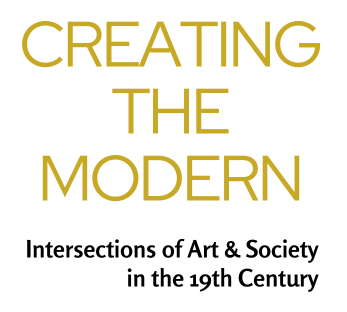
INTRODUCTION
NINETEENTH-CENTURY ART HISTORY is an extensive field of study that intersects with diverse areas of the humanities and social sciences. New research continues to expand our understanding of the era’s modernist ideation and cultural production. The aim of Creating the Modern is to facilitate access to the research by providing an online platform readily available to learners interested in examining the relationships between art, society and culture at the dawn of modernism.
Creating the Modern comprises ten chapters structured around general and specialized topics within an overarching chronology. In addition to addressing the era’s revolutionary aesthetic and stylistic developments, the e-publication engages issues relevant to nineteenth-century art within its socio-political context. Topics such as class and gender, academism and the avant-garde, the reception and consumption of progressive art, the culture of spectatorship, psycho-social illness, Eurocentrism, and religious and racial prejudice encourage a multi-faceted understanding of how the narrative of nineteenth-century art is a narrative intrinsically attached to the problematics, and promise, of emerging modernity.
The source material for Creating the Modern was gathered and collated exclusively from online publications, facilitating access and use and affording students and scholars across disciplines opportunities for further research and knowledge production. Extracts from original sources include texts by art historians, artists, philosophers, critics, and theorists, providing an expanded context of the artistic, literary, scientific, and social conditions that informed modern art. As an Open Education Resource (OER), Creating the Modern permits no-cost re-use, re-purpose, adaptation, and redistribution by others. To increase its accessibility and use, Creating the Modern is available through two formats: Pressbooks, an open-book creation platform best suited for re-adaptation, web-accessibility, and reading on Kindle and other web devices, and PDF, best suited for printing.
NAVIGATING THE WEB-VERSION
CONTENTS
Labelled “contents,” a navigation menu drops down from the top left-hand side of the open textbook in a typical web browser on a computer. It is also accessible to screenreaders. Notice that the + sign reveals the descriptive themes that comprise each chapter’s subsections.
SEARCH BOX
Notice the “search in book” and magnifying glass. It appears at the top right corner of a typical web browser on a computer and under a waffle menu on your phone/mobile device. Search the entire book for useful terms or artist names. For example, search results for van gogh indicate the sections where the artist’s name appears. After arriving at a relevant section, a control find helps to skim all passages for Van Gogh or other terms of choice. While the search is not case-sensitive, otherwise spelling the name or term differently from how it appears in the book will affect the results.
MULTIMEDIA CONTENT
In this image-rich open textbook, each image caption includes the option to view the source. You can quickly get to the image source; these hyperlinks allow you to see the details closer. Finally, amongst the helpful appendixes, which include a bibliography, biographical sketches of the artists, and a complete list of illustrations, the Youtube VIDEOS section offers links to instructional videos suited to each theme.

